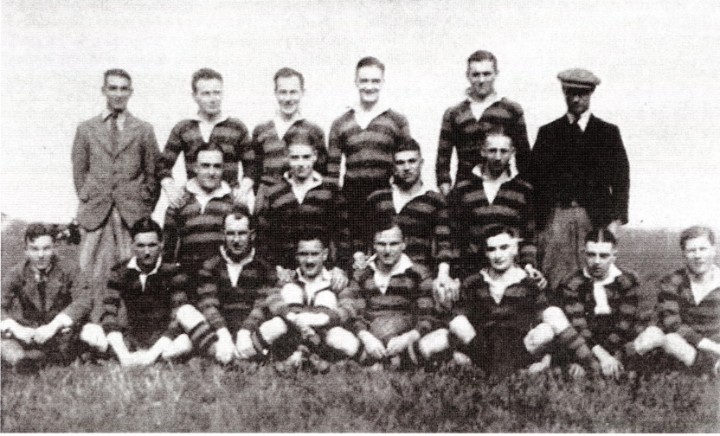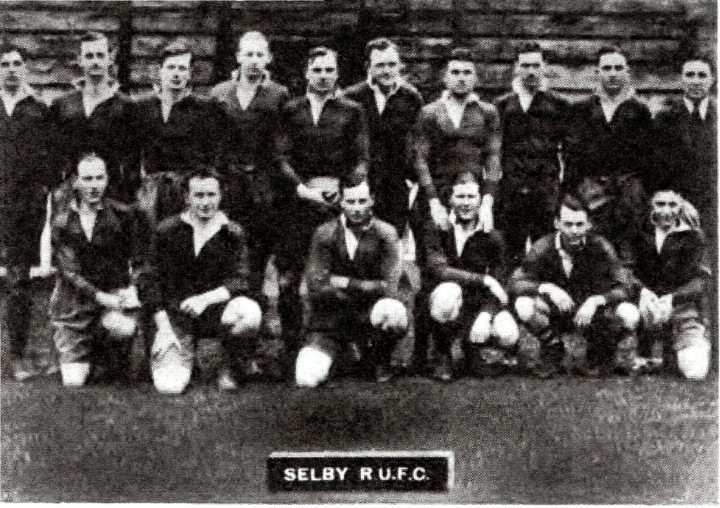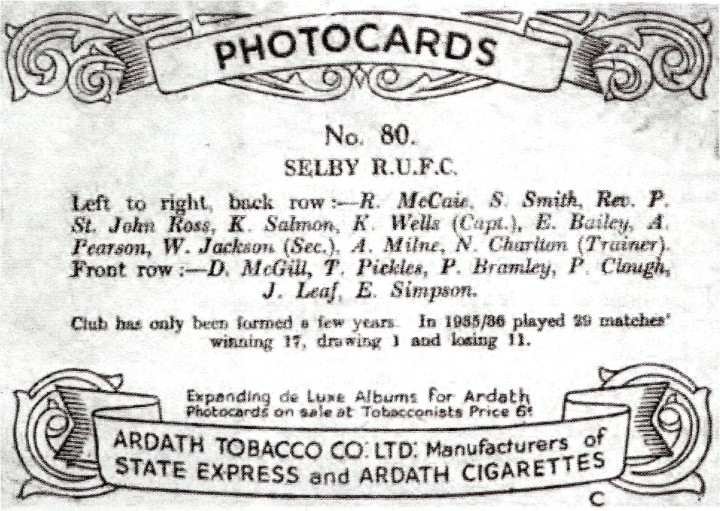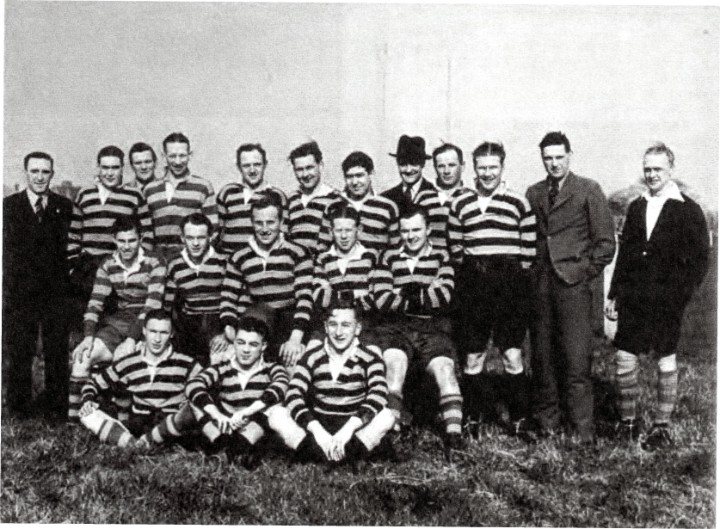3. Club History 1933-1945
Seiby R.U.F.C. was officially formed at a meeting held in the Museum Hall, Selby on Monday 11th December 1933. At the time there was considerable interest in rugby in the Selby area much of it created by a rugby playing school at Drax. In addition, before Drax started playing rugby in 1924, both Rugby Union and Rugby League had flourished in Selby.
The strong Rugby Union Club, which had provided two County players to Yorkshire faded out in the early years of the century. Rugby League was then played in the town until the early 1920s.
Following the opening meeting, a playing field at Burn was quickly secured and rented for the remainder of the season from Wilson Bros, for £2.10s.0d. Squire W. Swift provided the posts; 18 red and gold Tuff Knit jerseys were purchased for £5.18s.6d.; two balls acquired; 30 players insured and the ground marked by the Drax groundsman. All this was achieved quite amazingly in under three weeks and the first game was played on 30th December 1933.
The Club began with a 6-0 victory over the now defunct York YMCA at their Elmfield ground. The players representing Selby in that first match were: A. Wray, R. Pratt, K. Wells, K. Wales, G. Laycock, A. Weaver, A. Pearson, Stothard, S. Richardson, Jeffries, R. Turner, J. Latimer, D. Macgill, W. Jackson, H. Braithwaite.
A contemporary newspaper report said the forwards were outstanding but it was ex-Army wingman Bob Pratt who had the distinction of scoring Selby's first points with a well taken try. Fittingly, the second try came from Club Captain and centre Ken Wells.

Back Row:- K. C. Wales, 1. l, Pickles, D. Macgill, H. V. Braithwaite, H. Sherwood, F. Ullathorne.
Middle:- J. Ainley, A. Weaver, G. A. Pearson, K. R. Salmon.
Front:- W. G. M. Scarr, W. Jackson, N. Bulmer, B. M. Wishart, K. Wells, M. Garnett, R. W. Pratt,
W. P. A. Clough.
This was followed by the first home game against Cross Gates, another club no longer in existence. Five changes saw the introduction to the side of G. Scarr, E. Simpson, K. Salmon, N. Bulmer and H. Sherwood. There were also many positional changes most notably the switch of Richardson from hooker to full back. A beneficial effect must have been achieved because the side won 16-3, four tries coming from Braithwaite, Weaver, Wells and Pearson, with Wells and Pearson adding a conversion a piece.
After a win at Castleford, Selby their first defeat losing 8-13 to Morley A on 27th January 1934. Revenge came only a fortnight later, in the return fixture at Burn as Selby won convincingly 33-3.
Generally, the Club's winning ways continued and by the end of the season 9 games had been won, 2 drawn and 4 lost with 207 points for and only 82 against, a most satisfactory start.
Despite these early successes the Club was not content to rest on its laurels and was already looking for a better ground nearer Selby. By 6th February 1934 a suitable field had been found but the cost was far beyond the small cash balance accumulated in the first few weeks. Help arrived in the form of a syndicate of nine Club members who subscribed the necessary money and rented the ground back to the Club for £25 per year. During the close season the syndicate sold building plots around the ground to finance the seeding of the field and the building of a stand incorporating two changing rooms. Once again, progress was dynamic, and it soon became obvious that all the facilities would be ready for the start of the new season.
Present day members should be thankful for the foresight shown by the Committee at that time and the efficiency with which the work on the ground and stand was carried out. The first XV pitch is still in its original position, the stand remains as constructed with only minor repairs and alterations, and the first two changing rooms have only recently been enlarged.
In early May 1934 the Secretary wrote to Yorkshire R.F.U. with a request to send a team for an evening game to open the ground during September.
Mr. R. F. Oakes, the Yorkshire R.F.U. Secretary, obliged by raising a representative XV to play Selby on Thursday 20th September 1934. After the ground was officially opened by Yorkshire President Mr. W. L Haley, the R. F. Oakes team won an entertaining game by 25 points to 8. Yorkshire Captain and England winger Lewis Booth Scored all five tries for the Yorkshire XV while it was again Bob Pratt who scored for Selby. This was another good try by Bob despite an unfortunate newspaper misprint that inferred he played less than well.
The publicity arising from the game combined with the excellent facilities offered at the ground resulted in a dramatic expansion of the Club. An A team was started by the end of the season some 70 players turned out in the two sides. Total membership reached 150 but this did not satisfy the ambitious Club.
Secretary Walter Jackson - "To be a really successful Club we must have a large number of paying members as well as playing members" was his quote to the 1935 AGM.
The playing record in that first full season was quite exceptional. The 21 victories stood as a record for 33 years until broken by Terry Smith's 1968/69 side. One of the features of the season was an unbeaten run of fifteen matches starting with a Christmas win against the Drax G.S. Boarders side and ending in April with a defeat at Bramley.
Meanwhile, the A Team had played 16 games, winning 5 and drawing one but only conceding 120 points. The initial game for this side was played at New Lane, York when Selby fielded Stoker; Scarborough, Salmon, Simpson, Laycock; Jessop, Wishart; Macgill, Stripe, Pickles, Jeffries, Fishburn, Turner, Davidson, Duffin. Despite the inclusion of some established senior players, the A team went down 6-15 to Railway Institute A.


An initial attempt at seven-a-side Rugby also brought the first trophy with victory in the Hull and East Riding Sevens. As the Hull Mail report states, Selby played magnificently throughout the competition and showed excellent style in the final to beat Hornsea by 11-9. A rare game in May brought that first full season to an end with a victory over North Lincolnshire in a match played for King George's Jubilee Fund.
That season also saw the first Annual Rugby Dance which eventually became one of the better social events in the town. Held at the Baths Hall the dance contributed some £24 to club funds -the equivalent at 1983 prices of approximately £500.
However, all was not sweetness and light throughout the whole of the season. The Committee felt obliged to write to Featherstone cancelling the fixtures for 1935/36 stating that the Club did not appreciate their style of football. Unfortunately we do not have Featherstone's reply to this letter.
1935/36 saw no let up in the extension of the Club's activities. In July 1935, Captain Clough the President, was elected to the Yorkshire RFU Committee. His presence there must have had some effect because the Club was invited to stage the Yorkshire Shield final on Saturday 25th January 1936 (subsequently postponed to April because of weather conditions). The match was between the Duke of Wellington's Regiment and Old Hymerians with the former winning by 9 points to 3.
The nature of the arrangements for the final make an interesting comparison with the present day. One method of advertising was by means of a large poster displayed on a hand-cart travelling around the town and another the exhibiting of the trophy in the window of Messrs. Cheesemans, now Wetherells. Two A team players were also organised to act as ball boys, a role unlikely to be filled by today's second team.
The first tour took place at Easter and 18 players, apparently supplemented by some from other clubs, had a successful time beating Bridlington 18-3 but losing to Scarborough 3-9. The season was not, however, without its problems, the most notable being the saga of the Yorkshire Cup first round. The team arrived in Hull to play Hull Brunswick Avenue, but unfortunately left their shirts at Selby. The Hull side had the audacity to claim the match but were over-ruled by the County Committee who asked Selby to play the following week. The Selby Committee decided in their wisdom to withdraw from the Competition owing to the interference with ordinary fixtures, a situation discussed again in 1982 concerning the Yorkshire Shield.
Transport in those days was not without its difficulties and a delightful Minute from 12th November 1935 highlights the problems:"The Secretary was instructed to write a strong letter of protest to the B & S Bus Company complaining of the breakdown of buses during transport of players to away matches and asking for an explanation of what treatment the Club should expect in the future. If the reply be not satisfactory a sub-committee be appointed to interview the Manager of the Bus Company".
The playing record was once again very satisfactory with 60% of games won and a stronger fixture list than the previous year. Most satisfying was a double over Bramley O.B. who had brought the previous winning run to an end and there were good wins against Hessle, Doncaster, Wakefield A and Roundhay A. The A team, however, still struggled to raise a side and won just 3 of the 12 games played.
1936/7 at last saw a slackening of pace in the expansion of the Club. It was a fairly quiet season but once again Selby were honoured by being invited to stage a semifinal of the Yorkshire Shield between Castleford and Hornsea. Other noteworthy matters appear to be a straightening of the goal posts and the purchase of a tea urn.
On the playing front a club record was set which still stands today. The 67-3 win over Leeds Yarnbury on the 9th January 1937 is the highest first team total. Try scorers that day were Smith and Milne with 4 each, Leaf (3), Pearson (2), Bailey and Wishart. Brownbridge converted 11 of the 15 tries.
Throughout that period, county men Milne and Pearson were prolific scorers as also were Smith and Salmon. Not only was Milne a strong runner, but he also set up tries with the tactical use of the cross kick.
The next season started with the first Club Dinner on 4th September, this being the fore­runner of many subsequent successful dinners.
A notable landmark in the Club's history was achieved in November when Arthur Pearson was selected to play for Yorkshire against Ulster. Arthur was the Vice-Captain of the team at this stage but shortly after his successful debut for the County he appeared for Bradford. Not unnaturally the Committee took a rather dim view of this and reported Bradford to the Yorkshire Committee for approaching the player without any prior notification to the Selby Club. The matter was eventually resolved by Arthur Pearson resigning from Selby and the arrangement of fixtures with Bradford for the following season. In later years Arthur was to come back to the Club and continue a successful and happy association with the members.
What seemed to be a major setback arose in April 1938. A drought had set in on the East Coast and the Secretary of Hornsea notified Selby that unless there was some rain in the intervening period the Easter tour match was unlikely to be played. In some Clubs this could have caused much consternation but the spirit in the Club was so high that the following memorable Minute was noted in the Club records:
"Mr. Berry proposed and Mr. Gill seconded that the Easter tour be carried out even if both matches be cancelled - carried."
In the event, one game was played against Bridlington which Selby won by 11 points to 3. It seems to have been an excellent weekend as a cryptic note to the Secretary's report of that season records: "After two of our players had helped Bridlington to win their Easter Monday match we were left to make a leisurely if somewhat uncomfortable way home."
Once again the Selby Club was honoured with the Yorkshire Shield Final, this time between Goole O.B. and Hessle, Goole won a splendid game by 11 points to 6.
Bill Liversedge was elected Captain in 1937 and the last season before the war under his leadership saw an excellent sixteen victories recorded.
A nephew of President W. A. Clough, who died in 1938, Bill has continued his interest in the Club becoming President in his turn in the early 70's. The first of many family connections was started at this time as Bill's four Clough cousins followed him into the Selby colours. John and Peter were both in that useful side of 1938/39 whilst Miles and Pat were to play after the war.
A number of other brothers have since turned out for Selby including six Adamsons. Arthur Mooney also came into the side in the late 30's and, like Bill Liversedge, was later to become first Captain and then President. The family connection was strong here too as Arthur's father Sam joined the Club in an administrative capacity.

Back Row:- N. Charlton, J. H. Hughes, D. Jackson, K. R. Salmon, E. Bailey, J. H. Clough,
G. L.Robbins, P. Bramley, W. P. A. Clough, W. Jackson.
Middle:- J. Thompson, J. Leaf, W. H.Liversedge, A. Mooney, G. A. Simpson.
Front:- H. Noble, J. Noble, N. Gray.
Also left: N. Charlton Back: D. Jackson Right: W. Jackson.
Other stalwarts of this time were wingers Jack Thompson and George Simpson, Joe Leaf at half-back and Eric Bailey, Phil Bramley and Grodon Bobbins in the forwards.
Ken Salmon and Dave Macgill, who had played from the earliest matches in 1933/34 were still in the First XV while others, including Tommy Pickles were giving valuable service to the 'A' team. The question of floodlighting the ground for training purposes was discussed at length during 1938/9 but the high cost of running the electricity supply to the ground prevented any work going ahead at the time.
The intervention of War then brought to an end a very successful first six seasons for the new Selby Club. However, Don and Walter Jackson ensured that activities did not cease completely. Using both civilian and forces personnel they arranged many matches, both home and away, to keep Rugby going during the war.
